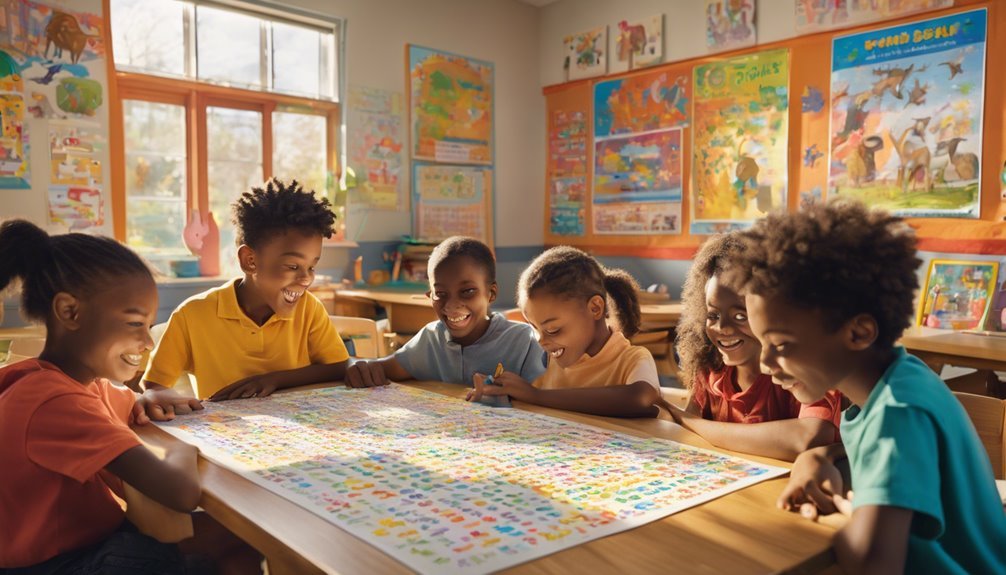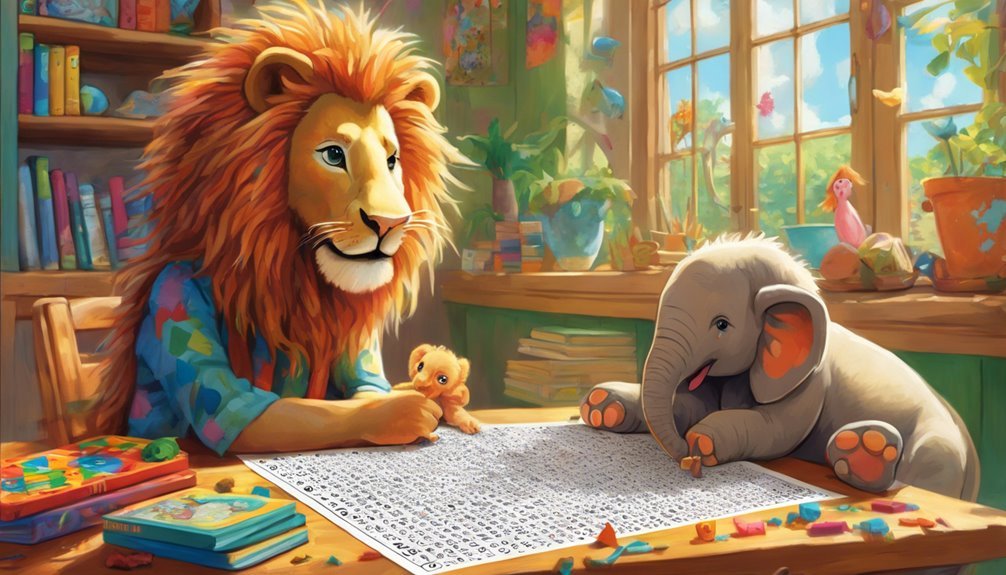How to Teach Kids About Animals With Word Search Puzzle Books
Teaching kids about animals can be a delightful adventure. Word search puzzle books offer a fun way to engage young minds while boosting their vocabulary. As they hunt for animal names, you can sprinkle in interesting facts that spark curiosity. But how do you choose the right puzzles to make this experience both enjoyable and educational? Let's explore some effective strategies that will keep kids enthusiastic about learning.
Key Takeaways
- Choose age-appropriate animal-themed puzzle books to engage children's interest and skill levels effectively.
- Incorporate fun animal facts to make the word search experience educational and enjoyable.
- Use puzzles as interactive warm-up activities or rewards to reinforce vocabulary and animal recognition.
- Foster teamwork by having kids work together on puzzles, enhancing collaboration and social skills.
- Introduce movement activities related to animals found in the puzzles to make learning dynamic and engaging.
The Benefits of Word Search Puzzles for Learning About Animals
When you dive into word search puzzles, not only do you have fun, but you also unlock a treasure trove of knowledge about animals. Each puzzle enhances your animal recognition skills as you search for names of various creatures.
You'll encounter everything from the majestic lion to the tiny ant, expanding your understanding of the animal kingdom. Plus, these puzzles aren't just about finding words; they're fantastic for vocabulary building.
By repeatedly seeing and searching for animal names, you'll reinforce your memory and improve your language skills. Engaging with these challenges helps you connect words with their meanings, making learning enjoyable and effective.
How to Choose the Right Puzzle Book for Your Child
How can you find the perfect puzzle book for your child? Start by considering their interests and age appropriateness. You'll want a book that matches their skill level and keeps them engaged.
Here are some key factors to consider:
- Age Group: Ensure the puzzles are suitable for your child's age.
- Puzzle Themes: Look for themes that interest your child, like animals, nature, or space.
- Difficulty Level: Choose puzzles that challenge them without causing frustration.
- Variety: A mix of word searches, crosswords, and other formats can keep things exciting.
- Illustrations: Colorful images can enhance the experience and draw your child in.
Creative Ways to Incorporate Word Searches Into Lesson Plans

Incorporating word searches into lesson plans can be a fun and effective way to reinforce learning. You can create interactive puzzles centered around animal themes, encouraging students to explore vocabulary related to different species, habitats, and behaviors.
Start by introducing a specific animal and then design a word search that highlights key terms. Consider using these puzzles as warm-up activities or as a reward after completing more challenging tasks.
You might even host a friendly competition, where students race to complete their puzzles first. This approach not only boosts engagement but also reinforces their understanding of animal-related concepts.
Fun Animal Facts to Include With Each Puzzle
Adding fun animal facts to each puzzle can make the learning experience even more exciting for kids. These facts can spark curiosity and deepen their understanding of animal habitats and endangered species.
Here are some engaging facts you can include:
- Did you know that the Amazon rainforest is home to over 40,000 plant species?
- The blue whale is the largest animal on Earth, reaching lengths of 100 feet!
- Sea turtles can live to be over 100 years old, but many are endangered due to habitat loss.
- Polar bears have black skin under their white fur, helping them absorb sunlight in their icy habitats.
- The African elephant is the largest land animal, and its population is currently threatened.
Incorporating these facts not only enhances the puzzles but also enriches your child's knowledge!
Encouraging Group Activities With Word Searches

While word searches may seem like simple puzzles, they can actually foster teamwork and communication among kids when done in groups. By working together, children engage in team building, learning to share ideas and strategies.
You can create a collaborative learning environment by dividing the kids into small groups, allowing them to tackle the puzzles collectively. Encourage them to discuss which words to look for and share their discoveries. This interaction not only enhances their problem-solving skills but also builds friendships as they celebrate each other's successes.
Plus, incorporating themes of animals into the puzzles can ignite their curiosity and enhance their understanding of wildlife, making learning both fun and educational.
Tips for Making Word Search Time More Interactive
How can you make word search time more interactive and engaging for kids? Try incorporating fun elements that blend learning with play. Here are some tips to elevate the experience:
- Introduce animal trivia: Share interesting facts about the animals they find.
- Create interactive games: Turn the search into a competition with timed challenges.
- Incorporate movement: Have kids act out the animals they discover after finding them.
- Use teamwork: Pair kids up to tackle puzzles together, fostering collaboration.
- Reward success: Give small prizes or stickers for completing puzzles or answering trivia correctly.
Frequently Asked Questions
How Can I Create My Own Animal-Themed Word Search Puzzles?
Creating your own animal-themed word search puzzles is a fun challenge! Start by choosing animal categories, like mammals, birds, or reptiles.
Decide on the puzzle difficulty—if it's for younger kids, keep the words short and few. For older kids, use longer words and more options.
Create a grid, fill it with letters, and hide the animal names. Finally, test the puzzle to ensure it's enjoyable and challenging.
You'll have a blast making them!
What Age Group Is Best Suited for Animal Word Search Puzzles?
Imagine a classroom buzzing with excitement, much like a nature documentary in full swing. When it comes to age groups for animal word search puzzles, preschool engagement often sparks curiosity, while elementary enjoyment dives deeper into learning.
Typically, kids aged 4 to 10 thrive on these activities. You'll find that younger children enjoy simpler puzzles, while older kids can tackle more complex ones, enhancing their vocabulary and animal knowledge along the way.
Are There Digital Versions of Animal Word Search Puzzles Available?
Yes, there are plenty of digital versions of animal word search puzzles available!
You can easily find these engaging resources on various online platforms. Websites and educational apps often offer interactive puzzles that boost learning while keeping it fun.
Plus, many of these digital resources allow you to customize puzzles based on your preferences, making it easy for you to challenge yourself or others at any skill level.
Enjoy exploring these exciting options!
How Can I Assess My Child's Learning Through Word Searches?
You can assess your child's learning by observing their engagement with word searches, much like a detective piecing together clues.
Check their puzzle comprehension by discussing the words they find and how they relate to broader learning outcomes. Ask them questions about the animals or themes they encounter.
This not only reinforces their knowledge but also encourages critical thinking. Celebrate their progress, making the learning process enjoyable and effective!
Can Word Searches Improve Vocabulary Related to Animals?
Absolutely! Word searches can significantly boost your child's animal vocabulary.
As they search for names of various animals, they engage with the words actively, enhancing their retention and understanding. This learning engagement helps them connect terms with images and meanings, making it easier to recall later.
Plus, you can encourage discussions about the animals they find, further enriching their vocabulary and knowledge. It's a fun and effective way to learn!
Conclusion
By integrating word search puzzles into your teaching, you're not just helping kids learn about animals; you're sparking their curiosity about the natural world. Imagine the excitement on their faces as they discover new creatures and facts! With the right puzzles and a bit of creativity, you can turn learning into an adventure. So, grab those puzzle books, and watch as your kids dive into the wild world of animals, one word at a time!








